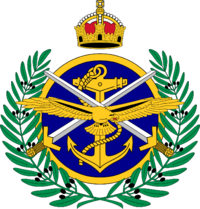Armed Forces of Insulamia: Difference between revisions
No edit summary |
No edit summary |
||
| Line 17: | Line 17: | ||
| url = {{url|afi.gov.ia}} | | url = {{url|afi.gov.ia}} | ||
<!-- Leadership --> | <!-- Leadership --> | ||
| commander-in-chief = {{wp|Elizabeth II}}, [[Monarchy of Insulamia|Queen of Insulamia]] | | commander-in-chief = {{plainlist| | ||
* {{wp|Elizabeth II}}, [[Monarchy of Insulamia|Queen of Insulamia]] | |||
* [[Edward de Saint-Pierre]], [[President of Insulamia]]}} | |||
| commander-in-chief_title = [[Commanders-in-chief of the Armed Forces of Insulamia|Commanders-in-chief]] | | commander-in-chief_title = [[Commanders-in-chief of the Armed Forces of Insulamia|Commanders-in-chief]] | ||
| chief minister = [[Joshua Canning]] | | chief minister = [[Joshua Canning]] | ||
Revision as of 12:12, 8 July 2022
| Armed Forces of Insulamia | |
|---|---|
| Forces Armées d'Insulamie | |
 Coat of arms of the Armed Forces of Insulamia | |
 Flag of the Armed Forces of Insulamia | |
| Founded | April 27, 1889 |
| Headquarters | National Headquarters for War, Franclinton, Henria |
| Website | afi |
| Leadership | |
| Commanders-in-chief | |
| Speaker of the Council of War | Air Marshal Lilly Olsen |
| Personnel | |
| Military age | 18–60 years old |
| Conscription | No |
| Active personnel | 9,171 (2020) |
| Reserve personnel | 14,265 (2020) |
| Expenditure | |
| Budget | |
| Percent of GDP | 0.21% (2020) |
| Industry | |
| Domestic suppliers | Itself Military-Industrial Department |
| Related articles | |
| History | Military history of Insulamia |
| Ranks | Armed forces ranks and insignia of Insulamia |
The Armed Forces of Insulamia (AFI; French: Forces Armées d'Insulamie) is the triservice military organisation of Insulamia, responsible for the defense of the nation. They also promote Insulamia's national interests, deliver humanitarian aid, and provide civil defense. It consists of three branches: the Army, the Navy, and the Avy. As of 2020, it has 9,171 active personnelle and 14,265 reserve personnelle, with an annual budget of IN£2.8 billion.
The Department of War, which itself is a department of the Ministry of Foreign Affairs, oversees the management of the AFI. Constitutionally, the commanders-in-chief of the AFI are the Queen and the President of Insulamia, who are also the heads of state. The operations of the AFI are managed by the Minister of Foreign Affairs, in collaboration with the Head of War and the Council of War.
The AFI was formed in 1893 as a union of the Aubertois Armed Forces, the Royal Henrian Defense Force, and several militias of Septentria. Prior to this, there were two provincial militaries operating in the country, each mostly managed by their respective provincial government, and several militias operating on behalf of the Government of Septentria. The Avy was founded in 1925 and incorporated into the AFI. Insulamia participated in the Battle of France in the Second World War, and later the landings at Normandy and the liberation of France. In 1983, Insulamia began a process of rapid demilitarisation, cutting the military budget in half and relegating the Ministry of War to a department under the Ministry of Foreign Affairs. Since then, the country has continued to steadily demilitarise, and, as of 2020, the AFI is one-quarter of the size that it was in 1980.
Currently, the AFI is a very small military, relative to other national militaries, though it is decently equipped and technologically sophisticated. Almost all military equipment used by the AFI is manufactured by the Federal government, specifically the Military-Industrial Department under the Ministry of Industry. The Department of Military Research under the Ministry of Science & Technology researches military technology for the Military-Industrial Department to manufacture.
History
Provincial armies and unification (1888–1914)
Following the federation of Insulamia, the country did not have a national armed forces. Instead, two provinces, Aubert and Henria, maintained their own militaries that were remnants of colonial militaries. There were several reasons for this, including a lingering distrust between the provinces, and the relative peacefulness of Insulamia which did not warrant a strong nor unified military. The Federal Government of Insulamia was also not focused on defense at the time and did not yet have a ministry for war. Septentria did not have an official armed forces, but the provincial government funded several militias tasked with defending the province; additionally, the Royal Henrian Defense Force would also come to Septentria's aid if attacked.